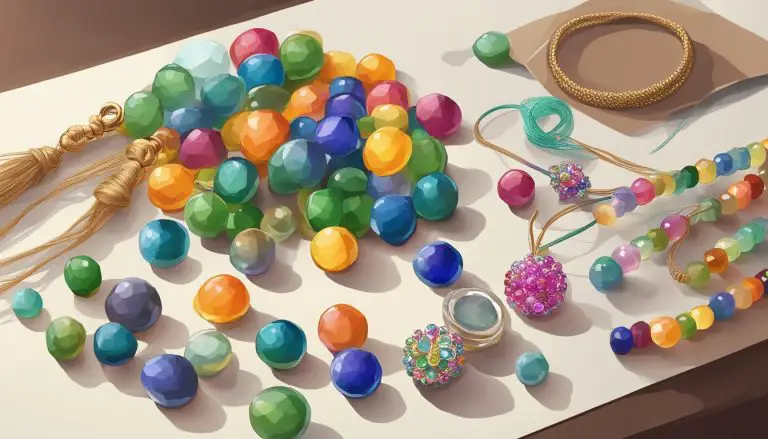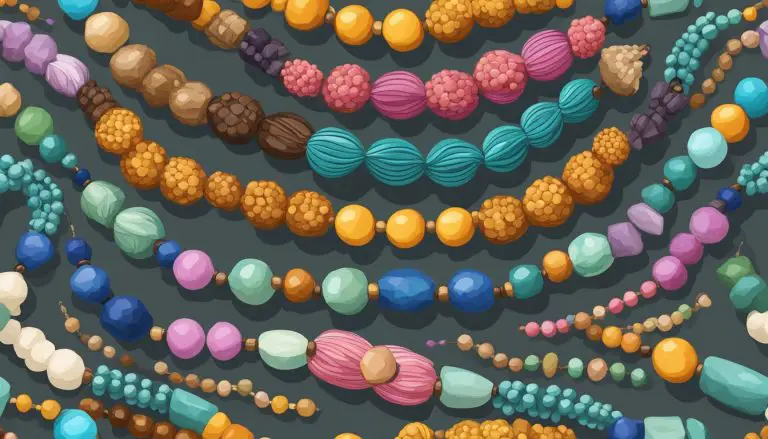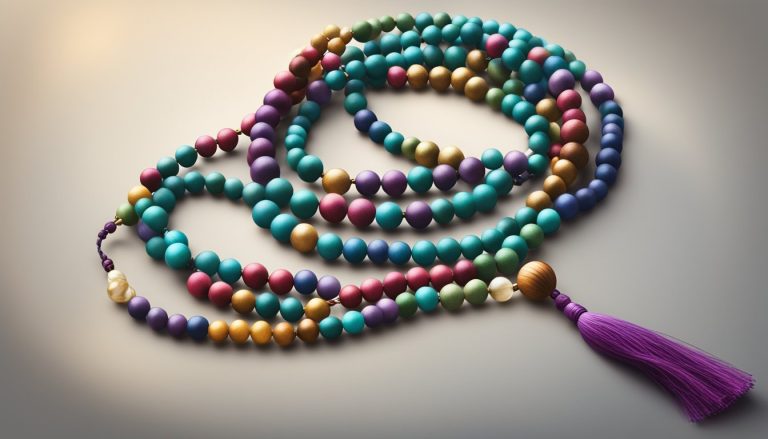Mala Beads and Mindfulness: Enhancing Your Meditation Practice
Mala beads have been used for centuries as tools in various spiritual and meditation practices.
Originally rooted in the traditions of Hinduism and Buddhism, these beads are often composed of 108 individual pieces and are used to keep count while reciting mantras, chanting, or mentally repeating a prayer or intention.
They serve as tactile reminders of a person’s spiritual journey.
Mala beads aim to promote a state of mindfulness, which is the psychological process of bringing one’s attention to the present moment.

Incorporating mala beads into meditation practice supports mindfulness by providing focus for the mind and helping to anchor thoughts. By moving through the beads with each breath or mantra, I find it easier to stay present and engaged in my meditation practice. It becomes not just a tool for spiritual connection but also a means to enhance my daily life, reducing stress and increasing concentration.
Key Points
- Mala beads are traditional tools used to aid in meditation and promote mindfulness.
- Mindfulness practices can be enhanced through the tactile use of mala beads during meditation.
- Proper maintenance of mala beads preserves their physical integrity and supports their spiritual significance.
Table of Contents
The Significance of Mala Beads
Mala beads have woven their way into the fabric of various meditative practices, often associated with a journey of mindfulness and spiritual connection.
Mala Beads in Different Traditions
In Hinduism, I find that mala beads often consist of Rudraksha seeds, associated with Lord Shiva and known for their unique texture. Buddhists favor materials like sandalwood or lotus seeds, each with their own significance, such as promoting tranquility or awakening the potential within. Malas are used in these traditions to keep count of recitations of mantras, which are sacred phrases in Sanskrit.
The Symbolism of 108 Beads
A common denominator across the traditions is the use of 108 beads. This number is considered sacred in Hinduism and Buddhism for various reasons. One reason is the belief that it represents the universe’s cosmic order. Some also say that there are 108 energy lines converging to form the heart chakra. At the end of a mala is the guru bead, which signifies the culmination of the meditation cycle and is used as a point of gratitude and reflection.
Material and Composition of Mala Beads
The composition of mala beads can vary significantly but typically includes a string with 108 beads plus the guru bead. I find that the materials chosen for these beads can range from rudraksha seeds and sandalwood to gemstones, each bringing different energy or focus to one’s practice. For instance, sandalwood is appreciated for its soothing fragrance, considered to aid in maintaining a calm state during meditation.
Meditation and Mindfulness Techniques
In exploring meditation and mindfulness, I’ve discovered tools and techniques that aid in cultivating presence and focus. Let me share insights on how mala beads can enrich your practice, whether through mantra meditation, breathwork, or yoga.
Mantra Meditation with Mala Beads
Mala beads serve as a tactile guide for Japa meditation, a form of mantra meditation. I use a mala, typically strung with 108 beads, to count the repetitions of a mantra. With each bead, I repeat a chosen mantra, which could be a word or phrase like “peace” or “I am calm.” This practice helps me maintain concentration and fully engage in the meditative process.
Breathing and Focus
Breath is the cornerstone of mindfulness practice. By paying careful attention to my breath—each inhale and exhale—I develop a deeper sense of focus. I notice the breath’s rhythm and use it as an anchor to the present moment, which not only calms the mind but enhances concentration.
Incorporating Mala Beads into Yoga
Integrating mala beads into my yoga sessions enriches the mindful aspect of the practice. In yoga, each pose or asana becomes an opportunity for meditation. As I transition from one pose to another, I sometimes pause to touch a bead, which grounds me in the moment and amplifies my attention to both my movement and breath.
Spiritual Significance and Practices

In my spiritual journey, I’ve discovered that using mala beads isn’t just a practice—it’s a pathway to connecting with the divine and fostering spiritual growth. Let me share with you how these sacred beads can elevate your spiritual rituals and intentions.
Connecting with the Divine
For centuries, mala beads have served as a tool for me to cultivate a deeper connection with the divine. Traditionally, a mala has 108 beads plus a larger ‘guru’ bead from which I start and end my meditation. The repitition of mantras as I pass each bead through my fingers keeps my mind focused on spiritual thoughts, channeling positive energy and love.
- Mantras: I choose mantras that resonate with my intention, whether I seek peace, compassion, or enlightenment.
- Intention: Each session starts with a declared intention, infusing my practice with purpose and direction.
Mala Beads and Spiritual Growth
Mala beads assist me on the path to spiritual growth by incorporating physical touch into meditation, creating a multisensory experience that deepens my mindfulness. The gemstones often used in mala beads also hold significance; they’re said to carry specific energies, which can enhance the spiritual experience based on my intention. Here’s how I integrate mala beads into my spiritual practices:
- Gemstones: I select malas with gemstones like quartz for clarity or amethyst for calming, aligning the beads’ energy with my personal needs.
- Inner Peace: The tactile nature of mala beads helps me channel inner peace, as I find rhythm and soothing repetition in their use.
Physical and Emotional Benefits

In my exploration of mala beads and mindfulness, I’ve discovered that the physical and emotional benefits are deeply interwoven. Each bead can carry unique healing properties, while the practice itself offers a sanctuary for stress and anxiety relief, as well as a tool to sharpen memory and focus.
Healing Properties of Different Beads
When I select mala beads, I often consider the specific healing properties of the crystals. For example, amethyst is said to promote hormonal balance and rose quartz often relates to heart health. By understanding the attributes of each bead, I can tailor my practice to address specific physical or emotional needs.
- Lapis Lazuli: It’s believed to benefit the respiratory and nervous systems.
- Clear Quartz: Known for enhancing energy flow and improving metabolic balance.
Mala Beads for Stress and Anxiety
I’ve found that the rhythmic practice of passing mala beads through my fingers can act as a grounding exercise to alleviate stress and anxiety. This simple, repetitive motion, paired with mindful breathing, helps calm my mind. Many people attest to a calming effect that aids in reducing blood pressure and promoting a sense of balance and relaxation.
- Calming: The tactile sensation of beadwork fosters a soothing environment.
- Grounding: Physically holding each bead keeps me present and centered.
Enhancing Memory and Focus
Incorporating mala beads into my meditation routine has also aided in enhancing my memory and focus. The concentration required to maintain the count of each bead without visual aid sharpens my cognitive abilities. It’s a mental exercise that, over time, has improved my attention span.
- Memory: Regular meditation with mala beads has been shown to improve recall.
- Focus: The single-pointed attention needed can heighten mental clarity and concentration.
Maintenance and Care of Mala Beads
When I first got my mala necklace, I quickly realized it needed proper care to maintain its integrity and beauty. This is especially true because it is often made from natural materials.
Here’s how I take care of mine:
-
-
Handling: I handle my mala gently and with clean hands to prevent natural oils and dirt from affecting the material. It’s particularly important for those malas with a tassel, as they can get tangled and dirty quite easily.
-
Cleaning: For cleaning the beads, I use a soft, dry cloth. If the beads are made from stones, a slightly damp cloth can help remove any accumulated dust. However, I’m careful not to soak them, as water can weaken the cord.
-
Restoring the Tassel: If the tassel becomes crumpled or distorted, I’ve found that lightly spritzing it with water and combing it through with my fingers can straighten the fibers.
-
Storage: When I’m not wearing my mala, I lay it flat or hang it up to keep the shape and prevent any unnecessary stress on the cord.
-
Regular Inspection: Occasionally, I inspect the cord for wear and tear. Since it’s a thread that can fray over time, it serves me as a reminder to handle my mala with care.
-
| Don’t | Do |
|---|---|
| Don’t expose to harsh chemicals | Do store in a clean, dry place |
| Don’t pull on the cord or tassel | Do handle with care and respect |
| Don’t immerse in water | Do clean gently with a dry or damp cloth |
Frequently Asked Questions
In this section, I’ll answer some common questions about the use of mala beads in mindfulness and meditation practices. These insights will help both beginners and seasoned practitioners understand the significance and proper usage of mala beads.
What is the significance of the number of beads on a mala?
The traditional mala has 108 beads, a sacred number in Hinduism, Buddhism, and other belief systems. This number is said to represent the universe’s completeness and is also linked to the chakras, or energy points, in the body.
Can mala beads enhance my meditation practice, and if so, how?
Yes, mala beads can enhance meditation by providing a tactile point of focus. They help me keep track of mantras and maintain rhythm during practice, which can deepen concentration and mindfulness.
What is the proper way to select mala beads for my personal use?
When selecting mala beads, I consider the material, the energy of the stones, and how they resonate with my intentions. It’s important to choose beads that feel right for me, as they will be my companions in meditation.
Are there any specific mantras recommended when using mala beads for meditation?
While there’s no one-size-fits-all mantra for everyone, some popular ones include “Om Mani Padme Hum” in Tibetan Buddhism and “So Hum” in vedic meditation. I pick a mantra that aligns with my intentions and use it consistently with my mala.
What materials are traditionally used to make mala beads, and do they have different meanings?
Mala beads are typically made from sandalwood, rudraksha seeds, rosewood, or gemstones. Different materials are believed to offer various spiritual properties; for example, sandalwood is known for its calming effect and rudraksha seeds are said to increase clarity and awareness.
How can I incorporate mala beads into my mindfulness routine to help with anxiety?
I use mala beads to anchor my mindfulness practice. I move bead to bead while focusing on my breath or mantra. This simple, repetitive action is a grounding technique. It can help alleviate anxiety by bringing my attention to the present moment.




